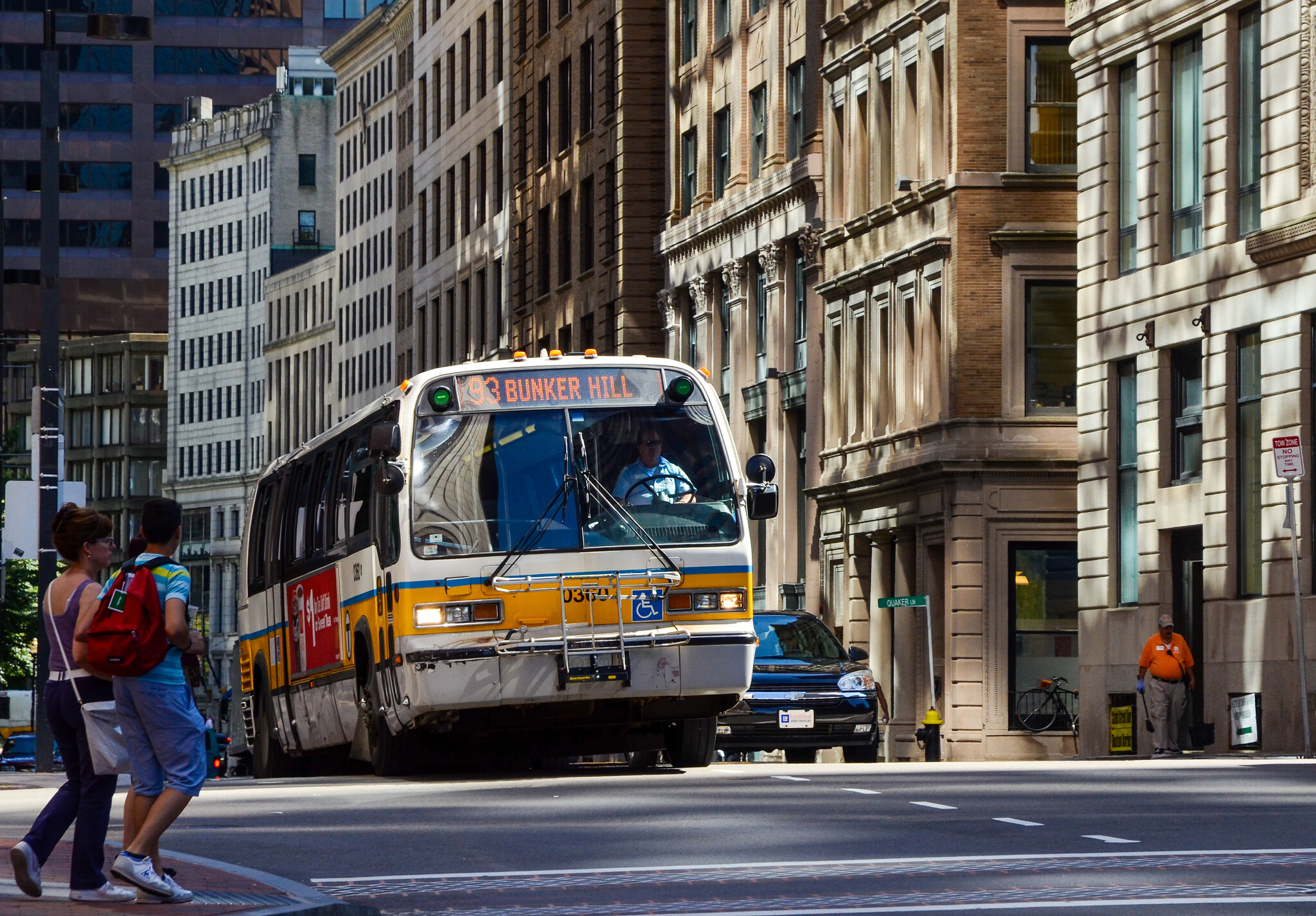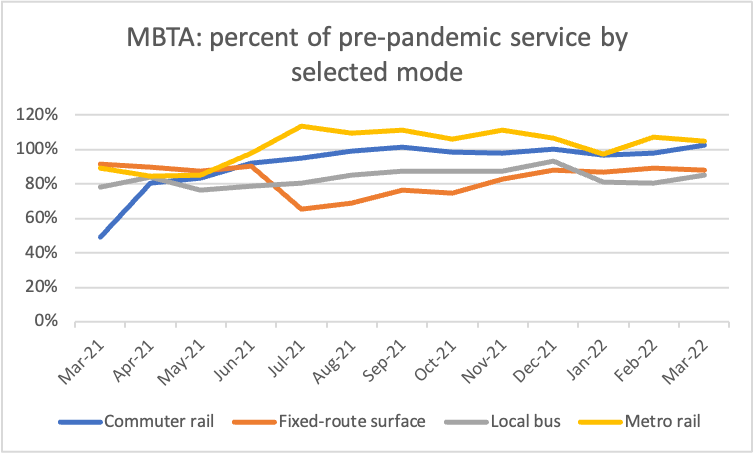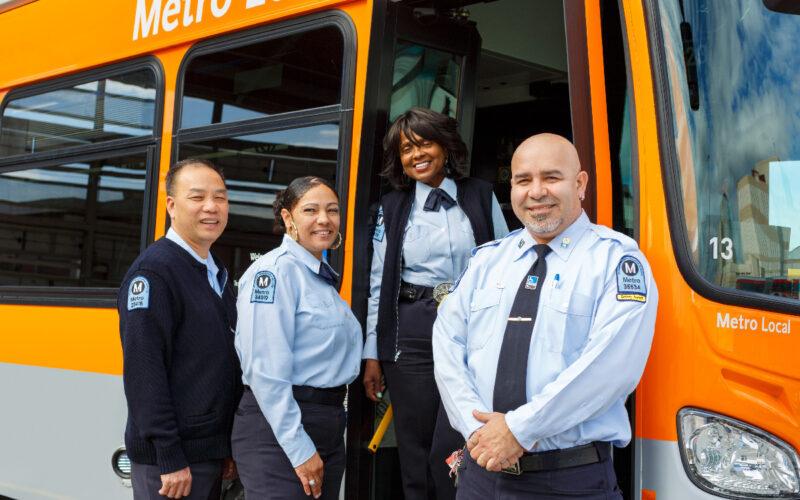
This week we’re running a series that looks into what’s happening with transit service in the seven highest ridership U.S. cities. Our goal with this series is to facilitate a shared understanding of the challenges agencies are facing, give riders a sense of what they can expect for the remainder of 2022, and surface ideas for how agencies can better mitigate disruptions.
What’s going on with service at Boston’s MBTA?

All chart data is from the Federal Transit Administration’s National Transit Database (Monthly Module Adjusted Data Release, April 2022. Service data is available through May 2022 but continues to be updated past its initial release–we include data only through April to ensure accuracy.) The fixed-route surface category consolidates light rail, streetcar, trolley bus, and cable car data. The local bus category consolidates local bus and rapid bus (BRT) data.
The MBTA was an early-pandemic leader in adapting its service patterns to better match new travel patterns, especially for essential workers and in communities of color. The agency was delivering close to 100% of pre-pandemic service throughout the first part of 2022
In June, however, directives from the Federal Transit Administration (FTA) forced the MBTA to cut its subway (heavy rail) service dramatically to lessen the heavy workload for subway dispatchers, which the FTA saw as a safety concern. (These service cuts are not reflected on the above chart). The Boston Globe reported that as of April 29th, four out of 18 heavy rail dispatcher positions and two out of 11 supervisor jobs were vacant. Commonwealth Magazine suggests that normal service may not resume until 2023, based on the training time required for new dispatchers. The result is that the recently strong service levels (approximately 98% of pre-pandemic service) on the Red, Orange, and Blue Lines have dropped to around 72-75%, according to the local advocacy group TransitMatters.
To compound the challenges, in late July the MBTA announced that it would need to shut down rail service on the Orange Line for a month to perform much-needed maintenance on the tracks. This closure begins August 19th.
The MBTA has maintained relatively high levels of service on other modes, but it has not been immune from the bus operator shortfalls that are disrupting the transit industry. The agency’s Lynsey Heffernan (Assistant General Manager for Policy & Transit Planning) told TransitCenter that “increasing bus service is . . . a goal for the MBTA, but is contingent on the MBTA successfully hiring bus operators. Hiring bus operators has been a challenge for the MBTA, like many transit agencies, and the T continues to pursue multiple efforts to increase hiring.”
Heffernan emphasizes that overall hiring represents the most significant challenge facing the agency, writing:
“The [MBTA]’s biggest challenge in delivering service continues to be hiring into key positions. Since late last year, the MBTA has pursued multiple strategies to increase the reach of our hiring efforts, the capacity of our Human Resources department, and the attractiveness of key roles. Efforts include:
– Media campaign to increase awareness for open positions
-Competitive signing bonuses for key positions
-Doubling HR staff
-Hosting in-person events, such as one-stop hiring fair and meet-and-greets to encourage and enable hiring”
Heffernan says that in order to meet the agency’s goals of delivering safe, reliable, and competitive service, the MBTA aims to accomplish the following in 2022:
-First and foremost, addressing ongoing safety concerns raised by the [FTA]. Over the last several weeks, the MBTA has implemented safety plans to address track conditions and maintenance, updated safety trainings and directives, and has addressed staffing shortages.
– Continuing to aggressively pursue hiring of key positions, including rail dispatchers and bus operators.
-Complete public engagement for our Bus Network Redesign, which is a complete re-imagining of the MBTA’s bus network and proposes a 25% increase in bus service, including additional high frequency routes and bus priority.
-Delivery of additional new Red and Orange line vehicles which are modern, more efficient and more spacious than previous vehicles.
-Complete major milestones for major projects as part of our $8B 5-year capital program, including investments in track, power and signals, such as the installation of our Green Line Train Protection System and our Red Line Signal Upgrades.
-Completion of the Green Line Extension, which extends the northern end of the Green Line to two new termini in Somerville and Medford, and adds six new stations and a new vehicle storage and maintenance facility”
Boston advocates have identified hiring, building institutional capacity, and the need for additional state funding as the most pressing issues facing the agency, as outlined in this recent TransitMatters explainer on the FTA’s emergency directives. The post highlights the MBTA’s limited budget, unfavorable collective bargaining agreements, and the pandemic as key impediments to attracting new operators:
“New hires are only guaranteed 30 hours of work per week, for uncompetitive wages and their schedules are determined by a seniority system that almost guarantees split shifts, odd hours, and inconvenient work locations.
COVID has also had an impact, and the booming economy and inflation meant that the MBTA now has to fight for workers where previously they held lotteries to distribute in-demand job positions.”
TransitMatters’ executive director Jarred Johnson stresses that the blame for the FTA’s directives should be shared amongst many players – the MBTA itself, Governor Charlie Baker, the State Legislature, and the new MBTA Board of Directors that has thus far been less responsive to and open with riders than their predecessors.
While the agency struggles to return to normal service, Johnson says that riders “want to know that the folks in charge are fighting for them.” He says the agency could minimize the negative effects on riders by offering more effective 24-hour shuttle service, fare discounts, boosting and expanding access to commuter rail service. He’s also calling for greater transparency about when normal service will resume, and better communication about what the Orange Line shut-down will accomplish.
Johnson also suggests that parking a Dunkin’ Donuts truck outside rail stations and serving coffee during particularly inconvenient service disruptions could go a long way in forming good will.
Read yesterday’s post in this series about what’s going on at LA Metro.
 On the Brink: Will WMATA’s Progress Be Erased by 2024?
On the Brink: Will WMATA’s Progress Be Erased by 2024?
The experience of being a WMATA rider has substantially improved over the last 18 months, thanks to changes the agency has made like adding off-peak service and simplifying fares. Things are about to get even better with the launch of all-door boarding later this fall, overnight bus service on some lines starting in December, and an ambitious plan to redesign the Metrobus network. But all of this could go away by July 1, 2024.
Read More New Drug Testing Rule from USDOT Could Help Alleviate the Bus Operator Crisis
New Drug Testing Rule from USDOT Could Help Alleviate the Bus Operator Crisis
New drug testing rules from the USDOT could make it easier for transit agencies to recruit more operators - but only if they implement the rule.
Read More